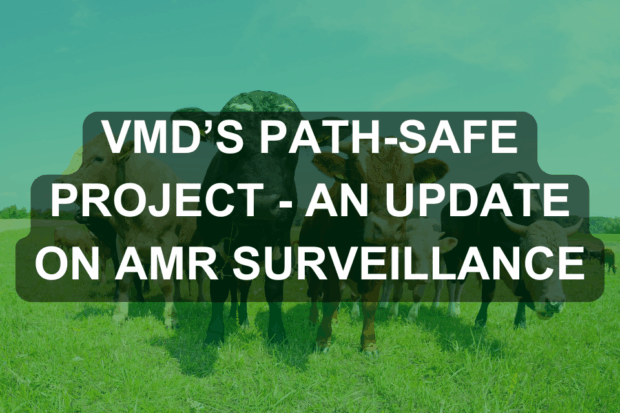
The Pathogen Surveillance in Agriculture, Food and Environment (PATH-SAFE) programme uses the latest DNA-sequencing technology and environmental sampling to improve the detection and tracking of foodborne disease and antimicrobial resistance (AMR).
The programme which is being led by the Food Standards Agency (FSA), was launched in 2021. As well as the VMD, it gave departments across government, including;
- Animal & Plant Health Agency (APHA)
- Defra
- UK Health Security Agency (UKHSA)
- Environment Agency (EA)
the opportunity to explore and investigate new areas of AMR surveillance along the agri-food chain.
What is VMD doing
Within the PATH-SAFE programme, we have looked to address commitments within the UK National Action Plan for AMR (2019-2024) including;
- identifying and addressing evidence gaps on AMR transmission pathways
- working with the private sector to share data
- commissioning research through collaboration and partnership
In the UK, through the harmonised monitoring programme, we conduct routine AMR surveillance in in two key livestock species, healthy pigs and poultry. The results from this are published yearly in the UK Veterinary Antimicrobial Resistance Sales and Surveillance (VARSS) report.
PATH-SAFE has provided the opportunity to bolster this surveillance through four AMR pilot surveillance projects which will help address key surveillance gaps, including generating baseline data for AMR in ruminants.
Read more about these four projects that the VMD’s AMR surveillance and evidence team kicked off in 2022:
1. Pilot surveillance of AMR in bulk milk
This project is investigating bulk milk as a novel tool for AMR surveillance in dairy cattle. It will test milk samples collected by the National Milk Laboratories (NML) to find out what AMR genes and AMR bacteria are present in bulk milk across GB.
This project is a great example of using the UK’s existing sample collecting infrastructure to expand AMR surveillance.
What is the evidence gap addressed
Currently, there is no routine surveillance of AMR bacteria in healthy ruminants. This survey will address this evidence gap by piloting AMR surveillance of bulk milk as an indicator of AMR levels in dairy cattle.
Who are we working with
National Milk Laboratories (NML) and APHA
2. Pilot survey of AMR in sheep
This project looks at AMR levels in healthy sheep at slaughter in England and Wales. Additionally, this project will pilot methodology for both environmental and wastewater sampling in abattoirs.
What is the evidence gap addressed
The last time there was a national survey of disease risk in healthy sheep in abattoirs was almost 20 years ago and therefore, existing data may not represent the current situation.
This survey will establish a new baseline of bacterial and AMR prevalence in healthy sheep at slaughter.
Who are we working with
APHA, FSA, Defra, Cefas and sheep abattoirs across the UK.
3. Pilot surveillance of livestock feed and feed ingredients
This project assesses the potential AMR risks associated with both domestic and imported feed ingredients and finished feed.
This will contribute to informing risk-based decisions about surveillance and control measures, which are essential for facilitating good biosecurity measures in the UK.
What is the evidence gap
Currently, there is no programme for monitoring AMR in domestic or imported animal feed ingredients in the UK.
Through this work we hope to generate a better understanding of the AMR load in imported feed ingredients.
Who are we working with
Agriculture Industries Confederation (AIC) and APHA.
4. Pilot Surveillance of AMR in beef cattle
This project will establish the prevalence of AMR in bacteria in healthy beef cattle.
Surveillance is being carried out in some of the key bacterial species, present in humans and animals, that are monitored in other surveillance programmes, allowing comparability of results.
What is the evidence gap
Cattle farming represents a significant sector within agriculture in the UK, with the UK being the third highest producer of beef in Europe in 2019.
However, there is no UK-wide programme for monitoring AMR in healthy cattle which makes it difficult to assess the risk of transmission across the agri-food chain.
Who are we working with
SRUC, FSS, AFBI and FSA
Looking forward
AMR surveillance is crucial for understanding the development and spread of AMR across animals, humans, food and the environment.
This helps us evaluate the risks to consumers, identify trends, and assess the impact of interventions aimed at slowing the spread of AMR.
The work done under the PATH-SAFE programme makes significant steps forward towards One Health Integrated Surveillance and the results from this programme will help inform and develop the new 5 year National Action Plan (2024-2029), due to be published next year.
Find out more about the PATH-SAFE programme and other research activities that are happening read the FSA blog.
Leave a comment